Researchers studying GPS data collected from the 1999 İzmit earthquake in Turkey found that the quake changed the movement of the plate, and this effect may be possible for other tectonic plates. Plus, more pretty images, starspots merging, melting Arctic sea ice, and minerals on Mars.
Podcast
Show Notes
Baby star stuns observers in Hubble Image
- NASA press release
Pulsar fires jets of antimatter (and matter)
- CXO press release
Magnetic fields bring together hotspots
- NASA Goddard press release
- “Pulse Peak Migration during the Outburst Decay of the Magnetar SGR 1830-0645: Crustal Motion and Magnetospheric Untwisting,” George Younes et al., 2022 January 13, The Astrophysical Journal Letters
Older Arctic ice melting at a disturbing rate
- AGU press release
- “Arctic Snow Depth, Ice Thickness, and Volume From ICESat-2 and CryoSat-2: 2018–2021,” Sahra Kacimi and Ron Kwok, 2022 March 10, Geophysical Research Letters
Mantle ‘blobs’ analyzed in new research
- ASU press release
- “Instability of the African large low-shear-wave-velocity province due to its low intrinsic density,” Qian Yuan and Mingming Li, 2022 March 10, Nature Geoscience
Earthquakes affect plate movement in a feedback loop
- Groundbreaking earthquake discovery: Risk models overlook an important element (EurekAlert)
- “Have the 1999 Izmit–Düzce earthquakes influenced the motion and seismicity of the Anatolian microplate?“, J Martin de Blas, G Iaffaldano, and E Calais, 2022 January 20, Geophysical Journal International
Mars meteorite hints at ancient Mars impacts
- Martian Meteorites Reveal Evidence of a Large Impact (Eos)
- “Impact and habitability scenarios for early Mars revisited based on a 4.45-Ga shocked zircon in regolith breccia,” Morgan A. Cox et al., 2022 February 2, Science Advances
Minerals record climate history
- Expanded knowledge of a mineral that helps decipher past climates (EurekAlert)
- “The Magnetic and Color Reflectance Properties of Hematite: From Earth to Mars,” Zhaoxia Jiang et al., 2021 November 29, Reviews of Geophysics
- “Innovative ochre processing and tool use in China 40,000 years ago,” Fa-Gang Wang et al., 2022 March 2, Nature
Transcript
Hello and welcome to Tuesday, the Ides of March. It is the kind of day when we remember that Julius Ceasar was stabbed by his friends, and on this stabby day, we’re going to look at high-energy jets that pierce the galaxy – including one jet that is firing away with anti-matter.
We also have a melting, rocking, occasionally beat up Earth, and more, right here on the Daily Space.
I am your host Dr. Pamela Gay.
And we’re here to put science in your brain.

I would like to start this story by saying this is not an illustration. If you are currently listening to this show as a podcast, and you aren’t driving your car, stop this recording and go to our website – DailySpace.org – to see this really amazing image of a new star being born. Don’t worry; we’ll still be here when you get back.
This image, taken by the Hubble Space Telescope, shows a very young star just starting to punch its way out of the cloud of material it formed in. This protostar is home to a bright jet that is spraying out material that didn’t quite make it into the star, and that material is lighting up as it interacts with its surroundings.
This particular system is cataloged as HH34, and it is 1,250 light-years away in the Orion Nebula — that fuzzy blob in Orion’s sword that you can just see with your eyes in a dark location. A favorite for everyone looking up, this region lets astronomers catch stars in all the different stages of formation. Herbig-Haro objects are very short-lived. The Pyramids of Giza may be older than this beautiful jet! Short-lived objects like this can actually be observed to change over human lifetimes, and Hubble has observed this and other HH objects over and over to try and understand how they, their stunning jets, and the surrounding nebulosity evolve as the central stars turn on.
Jets are one of the most dramatic features to crop up in astrophysics. Researchers don’t fully understand the details of how they form, but at the most basic level, magnetic fields can create beams of energy and particles that flow away from a spinning star or former star. Pulsars – the remnants of larger mass stars – are one of the most common sources of jets, and thanks to a new paper in The Astrophysical Journal, we now know these jets can – in just the right conditions – become a source of antimatter.
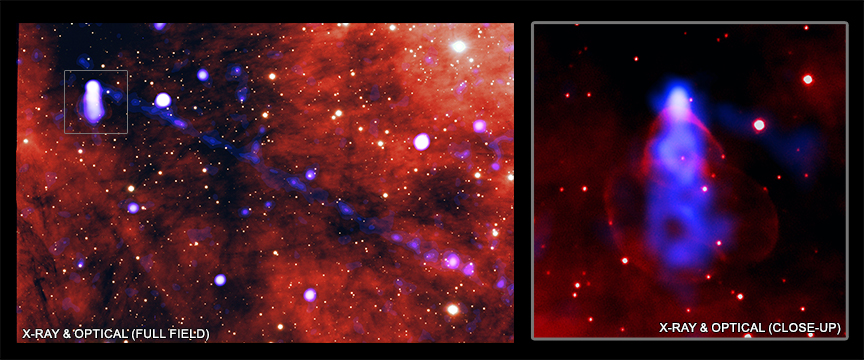
Images from the Chandra X-ray Observatory have captured a stream of positrons – the anti-matter sister particle to electrons – streaming for 40 trillion miles. Lead author of the work, Martijn de Vries, comments: It’s amazing that a pulsar that’s only 10 miles across can create a structure so big that we can see it from thousands of light-years away. With the same relative size, if the filament stretched from New York to Los Angeles the pulsar would be about 100 times smaller than the tiniest object visible to the naked eye.
This long filament has been able to answer some big questions for scientists. Researchers regularly detect positrons, and exactly where all this anti-matter comes from has been a bit of a mystery. In general, where there is a lot of energy, Einstein’s good old E=Mc^2 allows energy to become a pair of particles – matter and antimatter – such as a positron and electron.
The energies in this system are amazing. Not only are particles forming, but the particles in the filament are moving at roughly one-third the speed of light.
Researchers have previously seen high-energy halos that are forming particles surrounding pulsars, but they seemed confined by the surrounding material. This new example of a pulsar with a massive filament with positrons in it shows these antimatter generators can sometimes fling their contents across the galaxy.

Neutron stars come in many forms and are consistently amazing in their power and complexity. We now turn from pulsars to magnetars and look at the activities of SGR 1830-0645, which is nicknamed SGR 1830 for short.
Located about 13,000 light-years away in the direction of the constellation Scutum, this star gave off a burst of X-rays that were spotted by the Swift telescope on October 10, 2020. Follow-up observations with NASA’s Neutron star Interior Composition Explorer – or NICER – on the International Space Station (ISS) showed the system initially had three different hot spots that rotated through its view as the dead star rotated every 10.4 seconds. Over the next few weeks, those spots were seen to migrate closer and closer together.
According to NASA’s release on these observations: The results favor a model where the spots form and move as a result of crustal motion, in much the same way as the motion of tectonic plates on Earth drives seismic activity. … The team thinks these observations reveal a single active region where the crust has become partially molten, slowly deforming under magnetic stress. The three moving hot spots likely represent locations where coronal loops – similar to the bright, glowing arcs of plasma seen on the Sun – connect to the surface. The interplay between the loops and crustal motion drives the drifting and merging behavior.
From the high energies of stars to the quiet chaos of Earth, let’s now switch gears and look at crusts of a totally different kind.
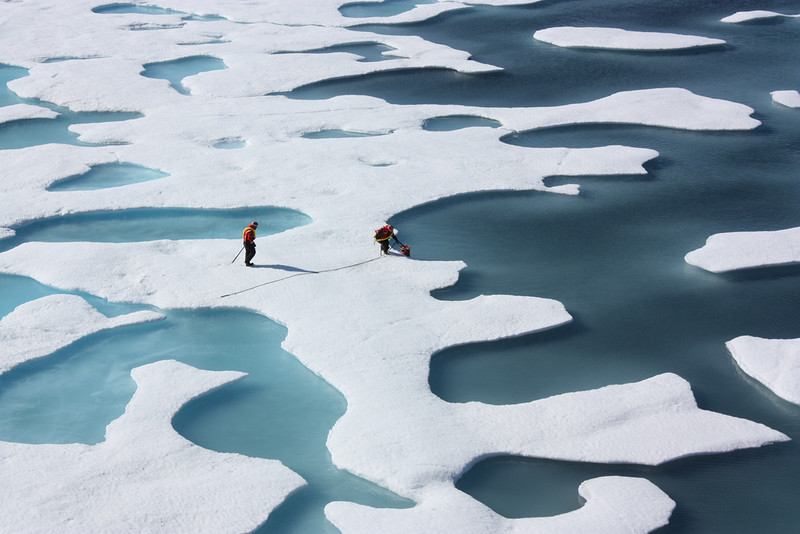
Last week, we brought you the story of a new NASA drone called Vanilla that is being used to measure the snow depth on top of Arctic ice. Understanding the depth of that snow means that we can remove it from satellite data on the thickness of the ice itself, leading to more accurate measurements. While NASA has been testing out their new drone, a team of scientists has used, for the first time, the combined data from lidar and radar satellites to do the same task.
The lidar satellite ICESat-2 and the radar satellite CryoSat-2 data were combined to estimate the snow depth as well as the height of the exposed sea ice that is above the waterline. The researchers analyzed the data and found that the volume of Arctic sea ice has decreased by 16% of its winter amount in just three years, losing about half a meter of thickness.
That’s not good. Lead author Sahra Kacimi also points out: We weren’t really expecting to see this decline, for the ice to be this much thinner in just three short years.
Again, here is why the snow depth is important. Snow is heavy, and the more it accumulates, the more it can weigh down sea ice, decreasing the amount that is above the waterline. Comparisons to climate records from previous studies show that the snow depth was being overestimated by about 20% or 0.2 meters. Co-author Ron Kwok notes: Arctic snow depth, sea ice thickness, and volume are three very challenging measurements to obtain. The key takeaway for me is the remarkable loss of Arctic winter sea ice volume — one-third of the winter ice volume lost over just 18 years — that accompanied a widely reported loss of old, thick Arctic sea ice and decline in end-of-summer ice extent.
And the bigger issue here is the loss of winter ice, which is thicker and more resistant to melting as opposed to seasonal ice that easily comes and goes. As the reservoir of older ice is depleted, the Arctic ice is more vulnerable to seasonal melting. Kacimi goes on to explain: Current models predict that by the mid-century we can expect ice-free summers in the Arctic, when the older ice, thick enough to survive the melt season is gone.
This work is published in Geophysical Research Letters, and frankly, is terrible news.
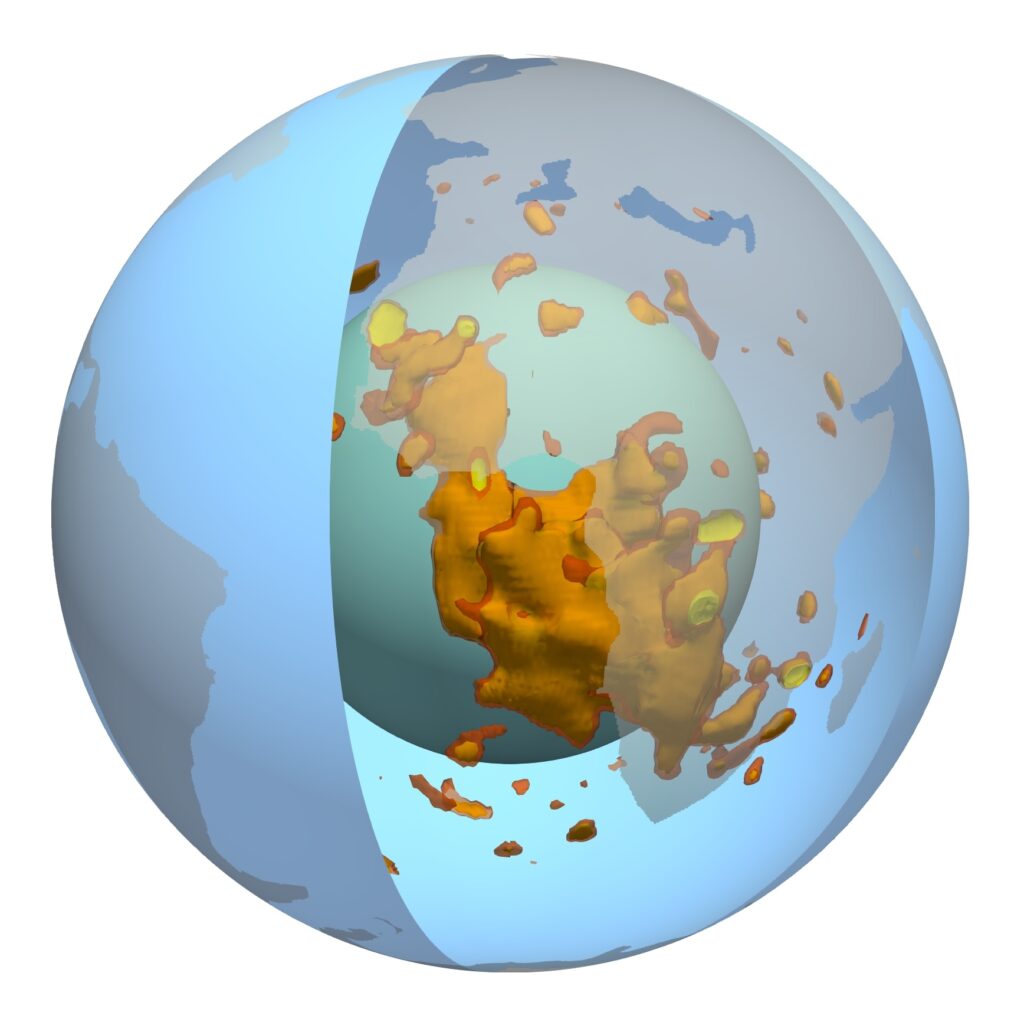
In less emotionally exhausting news, let’s work our way from the exterior of Earth to the interior and take a look at some research about our planet’s mantle.
So Earth is like an onion. Thank you, Shrek. It has many layers, starting with the continental crust, where all our land hangs out. Under that is the mantle, which is thick and viscous and sticky and warm, and the convection currents in the mantle make our plates move (more on that later). Beneath the mantle is a fluid outer core and a solid inner core, and those drive Earth’s magnetic field, without which we probably wouldn’t exist. Yay for magnetic fields!
In a new paper published in Nature Geoscience, scientists researched a couple of interesting features in our mantle called blobs. Well, formally, they are known as Large Low-Shear-Velocity Provinces or LLSVPs but “blob” is easier to say. And it’s rather descriptive since you can think of it like the blobs in a lava lamp. Remember lava lamps? No? Okay, we’re getting old around here.
Anyway, there are two major blobs in our mantle – one under Africa and one under the Pacific Ocean. These things are huge. They’re the size of an entire continent and over 100 times as tall as Mt. Everest. And they’re, well, blobby. Also, they’re not well understood, so these scientists did a seismic study of the two blobs to get a better handle on their size and shape and possibly how they affect the surrounding mantle.
Surprisingly, the African blob is 1,000 kilometers higher than the Pacific Ocean blob because it’s less dense, and that could further mean that these two blobs may have different compositions and different evolutions. Lead author Qian Yuan explains: Our calculations found that the initial volume of the blobs does not affect their height. The height of the blobs is mostly controlled by how dense they are and the viscosity of the surrounding mantle.
And co-author Mingming Li notes: The Africa LLVP may have been rising in recent geological time. This may explain the elevating surface topography and intense volcanism in eastern Africa.
This work is potentially the starting point for really understanding how our mantle processes came to be and how they operate as they do on a global scale, affecting and influencing plate tectonics.
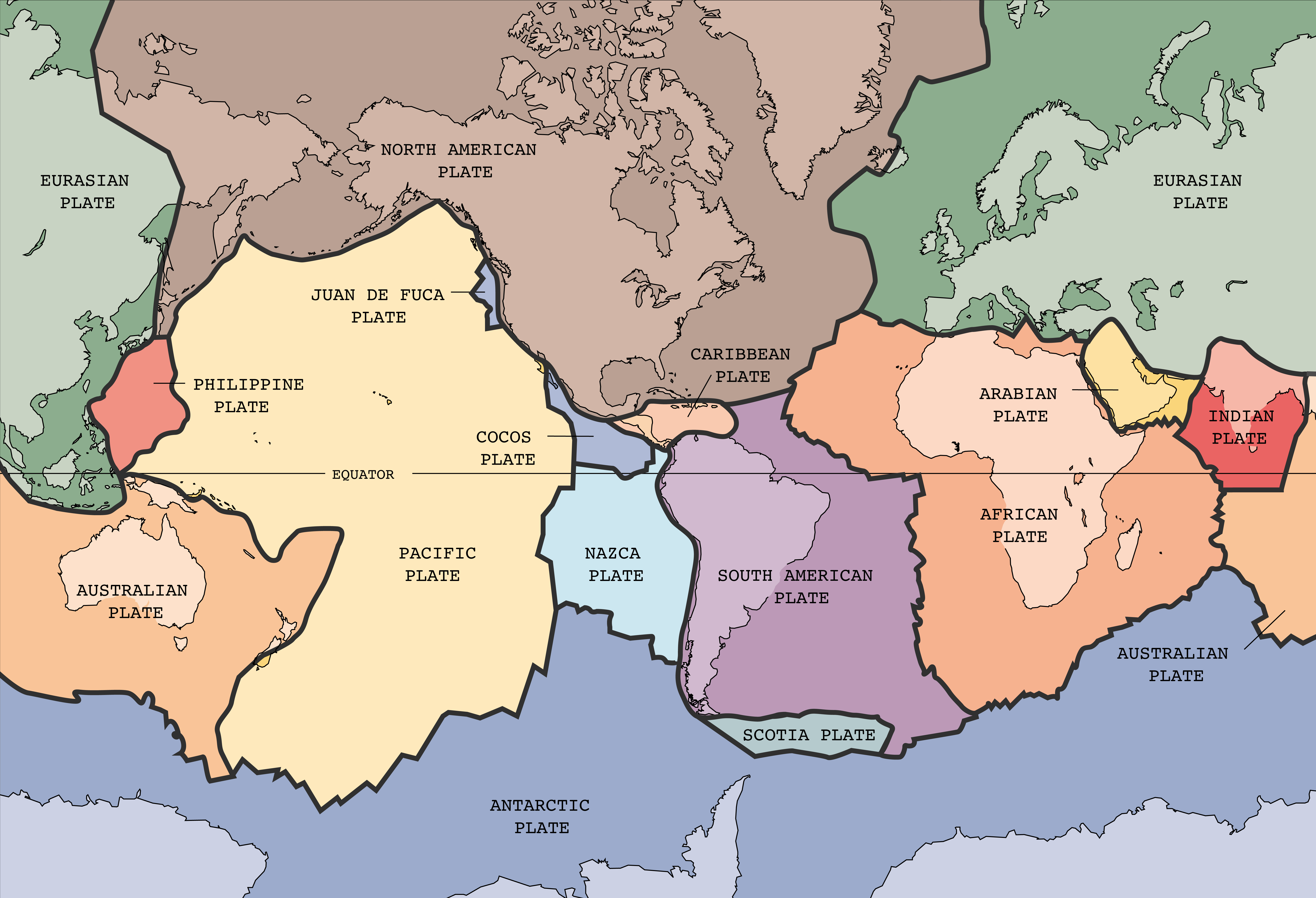
Speaking of plate tectonics, do you know what else affects the movement of the plates? Earthquakes. I know what you’re thinking. Plate movement causes earthquakes, not the other way around, but according to new research published in the Geophysical Journal International, the reverse is also true.
Researchers studied and analyzed the GPS data from the 1999 İzmit earthquake in Turkey, which was an incredibly strong and deadly quake that measured magnitude 7.6 and lasted just under a minute. The quake occurred on the North Anatolian Fault, a strike-slip fault similar to the San Andreas in California, where two plates are slides past each other. Turkey rests on a microplate called the Anatolian Plate, which is squashed between the Eurasian Plate and the Arabian Plate and being moved to the west about 2-2.5 centimeters a year as a result. That western movement means the plate scrapes against the other two plates, and bam, earthquakes.
However, that huge quake in 1999 changed the direction of the Anatolian Plate, and that change also influenced how often quakes happen there. Lead author Juan Martin De Blas explains: As the plate movements change, it somewhat affects the pattern of the later earthquakes. If a tectonic plate shifts direction or moves at a different rate than before, this potentially impacts the seismicity of its margins with neighboring plates.
And scientists need to take the effects of quakes themselves on plate movement into account when creating models for hazards. Co-author Giampiero Iaffaldano further explains: An important aspect of these models is that they operate under the assumption that plate movements remain constant. With this study, we can see that this isn’t the case. Therefore, the models can now be further evolved so they take the feedback mechanism that occurs following an earthquake into account, where plates shift direction and speed.
The team suggests that more GPS stations are needed in fault zones to monitor the plate interiors, away from those scraping edges where the earthquakes actually occur, to detect changes in the motion of the plates themselves. Of course, the team also notes that this research applies only to the Anatolian Plate due to the abundance of data collected from the 1999 İzmit earthquake, but they expect that results will be similar for other tectonic plates.
Earth keeps on moving and shaking, being the only planet with confirmed plate tectonics.

In the grand scheme of understanding hard things, understanding Earth is pretty easy. We can go out. We can dig, drill, and sample. While robots are starting to be able to poke at the surfaces of other worlds, they are limited and give us views of only a few miles along the surface and a few inches beneath.
Luckily, we occasionally get some free samples of Mars sent our way during impacts that can dig deep into the red planet. Basically, an asteroid hits Mars, the impact tosses chunks of Mars outward at escape velocity, and some lucky fragments get sent on a collision with Earth.
The bulk of these massive impacts occurred early in our solar system’s history, during a period called the Great Heavy Bombardment, during which – as the name implies – all the worlds were heavily bombarded by asteroids, comets, and other small and large objects, including the occasional now-dead planet.
After one such impact, a set of rocks took off on a flight through space that would bring them to crash into northwestern Africa. This would have happened only thousands of years ago and may have been seen by humans. For the interceding millennia, the black stones from space lay in the desert, undisturbed.
About ten years ago, these rocks happened to get scooped up and sliced up by researchers trying to figure out what kind of black rock randomly hangs out in the desert. The answer, as you may have guessed, was a Martian rock. Each meteor was made of a blend of material from Mars that had been crushed and then packed together. This diversity of material holds a record of all sorts of different events in Mars’s past. As described by Aaron Covosie: It’s truly a big smorgasbord of the early processes on Mars.
In this mixture were zircon crystals — 66 grains of zircon to be exact. Viewed under an electron microscope, these crystals showed irregular structures that indicated the crystal experienced an intense shock that compressed it like an accordion. We’ve seen similar crystals, called shock-twinned zircon, on Earth, and, as Cavosie explains: On Earth, nearly all occurrences of shock-twinned zircon are found in rocks from the central area of impact sites where pressures are highest.
This implies that these rocks are from the central part of an impact like those that formed Sudbury crater in Canada or Chicxulub in the Yucatan Peninsula.
It is super cool to get proof that impacts on Mars could affect zircon the same way that has happened on Earth. What is less cool are all the questions this sample can’t answer. Exactly when did it form? Not sure. The original zircon formed 4.45 billion years ago according to radioisotope dating, so the impact was sometime in the last 4.45 billion years, which isn’t helpful information. Where did the impact occur? The best we can say is “on Mars.”
Still, it’s cool. And it is more reason to want more robots digging on Mars.
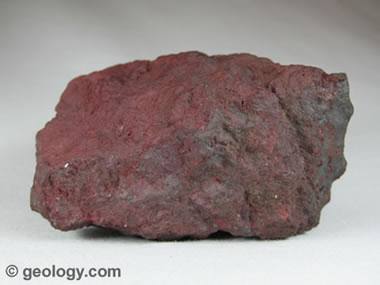
Just as fossils contain the history of past animals and plants, minerals can record the history of past planetary events and climates. One particularly good mineral for studying past climates is hematite. This reddish iron oxide mineral can form in watery environments, and in a review paper led by Zhaoxia Jiang, researchers start to break down what the different characteristics of this mineral mean and which do and don’t require water.
Basically, they want to see if we can use hematite to understand the past climate of Mars. It’s a common mineral on the surface and has been found in spectral data taken of Mount Sharp in Gale Crater, where Curiosity is currently wandering around. Those regions where hematite is found on Mars could be the key to searching for potential past biologic life on the red planet. Perhaps we could determine if there were even monsoons, not just water in general.
Published in Reviews of Geophysics, this paper builds on prior work using magnetic studies of hematite that analyzed archeological finds as well. Hematite affects the behavior of phosphorous in the soil, which is necessary for crop fertilization and not the easiest element to obtain.
So with one common mineral, we can learn more about both our own Earth and about Mars. Pretty good for a bunch of red rocks.
This has been the Daily Space.
You can find more information on all our stories, including images, at DailySpace.org. As always, we’re here thanks to the donations of people like you. If you like our content, please consider joining our Patreon at Patreon.com/CosmoQuestX.
Credits
Written by Pamela Gay, Beth Johnson, and Erik Madaus
Hosted by Pamela Gay, Beth Johnson, and Erik Madaus
Audio and Video Editing by Ally Pelphrey
Content Editing by Beth Johnson
Intro and Outro music by Kevin MacLeod, https://incompetech.com/music/


 We record most shows live, on Twitch. Follow us today to get alerts when we go live.
We record most shows live, on Twitch. Follow us today to get alerts when we go live.